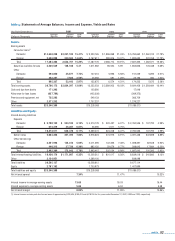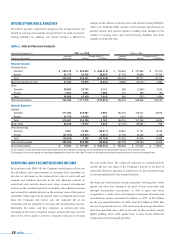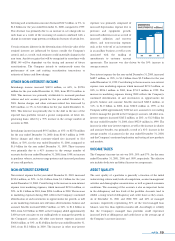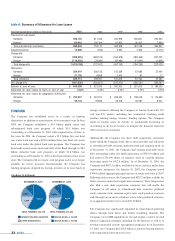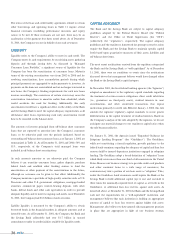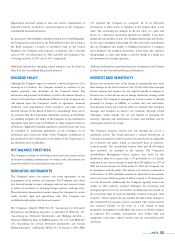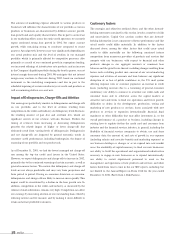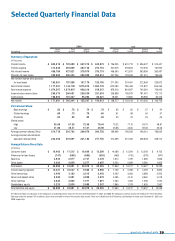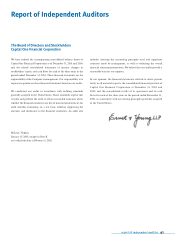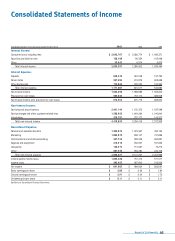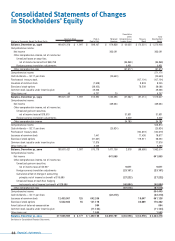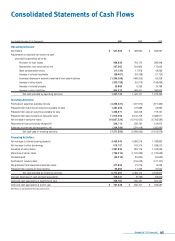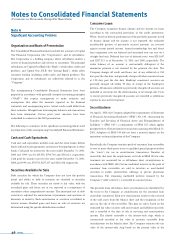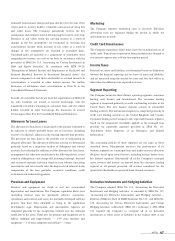Capital One 2001 Annual Report Download - page 39
Download and view the complete annual report
Please find page 39 of the 2001 Capital One annual report below. You can navigate through the pages in the report by either clicking on the pages listed below, or by using the keyword search tool below to find specific information within the annual report.
other customized card products are characterized by lower credit lines,
higher yields (including fees) and, in some cases, higher delinquencies
and credit loss rates. These products also involve higher operational
costs but exhibit better response rates, less adverse selection, less
attrition and a greater ability to reprice than traditional products. More
importantly, on a portfolio basis, these customized products continue
to have less volatile returns than traditional products in recent market
conditions, based partly on our ability to diversify risk. Based in part
on the success of this range of products and continued significant
offerings of introductory rate products, we expect strong growth in
our managed loan balances during 2002. We believe that we can
continue to gain market share and to grow accounts and loan balances,
despite our expectation that the credit card industry as a whole will
continue to experience slower growth.
Partnership finance relationships have continued to grow through the
fourth quarter of 2001. We recently announced a new alliance with
TJX Companies, Inc. to offer credit cards to their customers. We
anticipate entering into more alliances of this nature through 2002 as
opportunities arise to utilize our IBS strategy to originate accounts
through partnering relationships.
Capital One Auto Finance, Inc., our automobile finance subsidiary,
offers loans, secured by automobiles, through dealer networks and
through direct-to-consumer channels throughout the United States.As
with our credit card lending, we have applied IBS to our auto finance
lending activities by reinventing existing products and creating new
products to optimize pricing and customer selection, and to
implement our conservative risk management strategy. In October
2001, we acquired PeopleFirst, Inc., the largest online provider of direct
motor vehicle loans. We anticipate continued significant auto finance
lending activities growth during 2002.
We have expanded our existing operations outside of the United States
and have experienced growth in the number of accounts and loan
balances in our international business. To date, our principal
operations outside of the United States have been in the United
Kingdom, with additional operations in Canada, France and South
Africa. Our bank in the United Kingdom has authority to conduct full-
service operations to support the continued growth of our United
Kingdom business and any future business in Europe. We anticipate
entering and doing business in additional countries from time to time
as opportunities arise.
We will continue to apply our IBS in an effort to balance the mix of
credit card products with other financial products and services to
optimize profitability within the context of acceptable risk. We
continually test new product offerings and pricing combinations, using
IBS, to target different consumer groups. The number of tests we
conduct has increased each year since 1994 and we expect further
increases in 2002. Our growth through expansion and product
diversification, however, will be affected by our ability to build
internally or acquire the necessary operational and organizational
infrastructure, recruit experienced personnel, fund these new
businesses and manage expenses. Although we believe we have the
personnel, financial resources and business strategy necessary for
continued success, there can be no assurance that our results of
operations and financial condition in the future will reflect our
historical financial performance.
Marketing Investment
We expect our 2002 marketing expenses to exceed the marketing
expense level in 2001, as we continue to invest marketing funds in
various consumer lending products and services. Our marketing
expenditures reached their highest level to date in the fourth quarter of
2001, with a continued focus on capitalizing on the opportunities that
we see in the market.
We also plan to continue our focus on a brand marketing, or “brand
awareness,” strategy with the intent of building a branded franchise to
support our IBS and mass customization strategies. We caution,
however, that an increase in marketing expenses does not necessarily
equate to a comparable increase in outstanding balances or accounts
based on historical results. As our portfolio continues to grow,
generating balances and accounts to offset attrition requires increasing
amounts of marketing. Although we are one of the leading direct mail
marketers in the credit card industry, increased mail volume
throughout the industry indicates that competition in customer
mailings is at near record levels. This intense competition in the credit
card market has resulted in an industry-wide reduction in both credit
card response rates and the productivity of marketing dollars invested
in that line of business, both of which may affect us more significantly
in 2002. Furthermore, the cost to acquire new accounts varies across
product lines and is expected to rise as we continue to move beyond
the domestic card lending activities. With competition affecting the
profitability of traditional card products, we have been allocating, and
expect to continue to allocate, a greater portion of our marketing
expense to other customized credit card products and other financial
products. We intend to continue a flexible approach in our allocation
of marketing expenses. The actual amount of marketing investment is
subject to a variety of external and internal factors, such as
competition in the consumer credit industry, general economic
conditions affecting consumer credit performance, the asset quality of
our portfolio and the identification of market opportunities across
product lines that exceed our targeted rates of return on investment.
md&a 37


